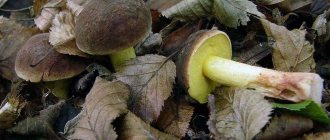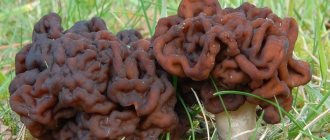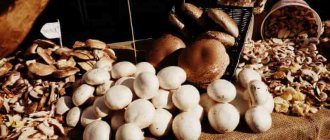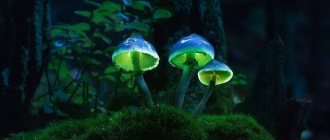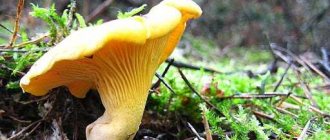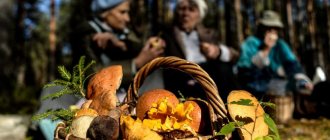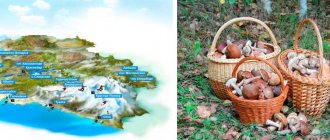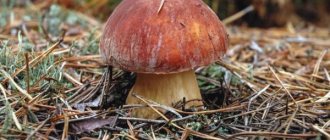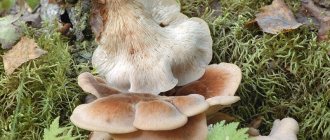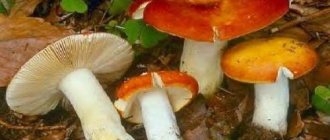Tubular fungi belong to the basidiomycetes. They differ from lamellar ones in their unique structure, similar to a sponge. This structure is called a “tubular hymenophore”. Only a few subspecies of the mushroom kingdom have such a structure - mycorrhiza-forming ones (well-known porcini mushrooms, boletus mushrooms, etc.) and tinder fungi (parasitic mushrooms). Such mushrooms are very valuable - they have a rich mushroom or nutty aroma, are better digested and absorbed by people than lamellar ones, and are especially more nutritious, since when cooked they release a special mushroom oiliness.
Characteristics and features of tubular mushrooms
Most tubular mushrooms grow large in size and have a large, cushion-shaped cap. When cooked, such specimens are capable of boiling down 3 times and releasing a large amount of moisture, since a lot of water accumulates in the tubular “cushion” itself (especially after heavy rains).
Features of mushrooms:
- the cap is always convex;
- few poisonous species;
- soft and springy layer of sporozoans;
- spongy surface may change color;
- insects eat tubular representatives with appetite.
- The temperate Russian climate is suitable.
Lamellar
Lamellar mushrooms are considered one of the most common on the planet. They can be found in almost any forest or garden. The hymenophore of the fruiting body is presented in the form of small thin plates, closely adjacent to each other. It is because of this feature that the group got its name.
Structure
The fruiting body of lamellar fruits is annual. It may have fleshy or leathery flesh. It all depends on the place where the species grows and its individual natural characteristics. Under the cap are the treasured plates - hymenophores. This part performs one of the key functions - it carries the spore-bearing layer.
In some mushrooms the hymenophore fits tightly to the cap. In other cases, it remains unsecured. There are also species in which the plates are attached directly to the stem.
hat
As mentioned earlier, a feature of the caps of agaric mushrooms is the presence of a spore-bearing layer on their lower tier. The shape of this part may vary. It all depends on the specific type of individual. The caps of some specimens may resemble a concave cone, which will straighten as they grow or fit tightly to the stem throughout the entire life cycle. This function is necessary to reliably protect the hymenophore.
Leg
Consists of an astonishing number of thread-like fibers. The leg can be a hollow cylinder or dense.
Peculiarity
There are two main features that distinguish agaric mushrooms from other representatives of the kingdom, namely:
- At the beginning of the life cycle, the fruiting body of an individual is covered with a special film - volva. It bursts as it grows and fits tightly to the leg. Helps in further species identification.
- When broken, most of the lamellar ones secrete a bitterish juice that looks like milk. It can be thick, watery or completely transparent.
Fruit bodies are presented in a number of shades: light brown, yellow, red, purple.
Where can I meet you?
Many representatives of the lamellar group can be found in the following places:
- wooded areas;
- fields;
- parks;
- ravines;
- beams;
- gardens.
It is necessary to pay attention to those areas where sandy loam soil is present in sufficient quantities and there is a high level of humidity. These mushrooms especially love rotted wood and compost.
Edible
Lamellar are represented by a wide range of edible specimens. Their taste qualities are appreciated by mushroom pickers and lovers of mushroom dishes. They are actively used for frying and drying, as well as for pickling. These include honey mushrooms, champignons, oyster mushrooms, rows, morels, saffron milk caps, as well as:
- chanterelles;
- Russula;
- waves;
- valui;
- cobwebs;
- wet.
The lamellar ones begin to bear fruit in early March. The quiet hunt ends only in late autumn, which is a great success for mushroom pickers. One of the few disadvantages regarding these mushrooms is their excessive fragility.
Inedible
Among the lamellar mushrooms there are quite a lot of mushrooms that are poisonous and dangerous to human health. They can cause severe symptoms of poisoning. They are worth remembering to avoid unpleasant situations. These include:
- fly agarics;
- entholomas;
- toadstools;
- false honey mushrooms;
- milk mushrooms (olive-black);
- lacticians;
- pipolifolia;
- violins.
Some inedible mushrooms have a deceptive, attractive appearance, which can often confuse even an experienced mushroom picker. To be sure to distinguish a safe specimen from a “friendly” one, you need to sniff it properly. Poisonous species give themselves away with a bitter, unpleasant odor.
Both tubular and plate-shaped varieties can be found on supermarket shelves. But it is much more interesting to discover representatives of the mushroom kingdom in a forest or clearing. A dinner made from personally collected mushrooms will please you much more than dishes made from purchased specimens.
Beneficial features
In ancient times, it was believed that decoctions based on oil can help get rid of health problems, avoid headaches, as well as other problems associated with the gastrointestinal tract.
Scientists still haven’t figured out whether this is true or not. However, the fact that the mushroom is incredibly useful, due to its composition, has been proven with one hundred percent accuracy.
Beneficial features:
- Fresh butternuts can synthesize large amounts of vitamin D, which is essential for the body.
- Mushrooms do an excellent job of removing impurities from the body, removing waste and toxins.
- The composition contains Omega-3 acid, which the body really needs in order to replenish the amount of this substance.
- The fruiting body has disinfectant properties, which means it can cleanse the body well of waste and toxins.
- Fights diabetes.
- The decoction helps you fall asleep faster.
Tips for beginner mushroom pickers
When going into the forest for the first time on a “quiet hunt”, and not knowing all the intricacies of this matter, inexperienced mushroom pickers can make certain mistakes. But this process is very responsible, so it must be taken seriously. To reap a bountiful harvest and not bring home poisonous fruits, you must follow these rules:
- Choose the right clothes and shoes. It is important to protect your hands and body from forest insects and ticks. It is recommended to wear gloves on your hands and choose closed shoes, even in the hot season.
- Do not touch unfamiliar mushrooms with your hands. If the fruit grows on the ground, then to get to it you need to use a wooden stick or twig. This will protect against poison getting on the skin of your hands (if the fruit contains toxic substances).
- Wear rubber gloves when working with fruiting bodies. This is especially important in the case when the picked mushroom needs to be examined in more detail, broken or cut, in order to understand whether it is poisonous.
- Conduct initial cleaning of fruits directly in the forest. All large debris is removed from the surface of the mushrooms, after which it is carefully inspected. If there is a passage from a worm or insect, it is recommended to cut the mushroom in half. If there are a large number of internal passages in the pulp, the spoiled specimen should be thrown away. If this is not done, the insect or worm may move to suitable mushrooms lying in one basket.
Upon arrival home, starting to sort through the harvest, the mushroom picker will notice poisonous specimens in the same basket with edible ones, then, unfortunately, you will have to get rid of the entire harvest. Therefore, it is very important to carefully examine and study all the fruiting bodies while still in the forest, so as not to encounter an unpleasant surprise later.
Edibility
Now the butter dish is classified as edible. However, remember that there are also their doubles, which are not recommended to be eaten. In order to distinguish a real mushroom from its not entirely edible counterpart, you need to know what to look for.
Despite the fact that there is a distinction between false and real boletus, both can be eaten. The main difference is that false species have a specific taste and can also lead to mild poisoning.
Nutrition
Since fungi, unlike plants, do not have chloroplasts and other plastids, they cannot obtain food through photosynthesis.
They acquire organic and inorganic substances useful for growth and development by absorbing water from the soil by the mycelium.
Often, hyphae penetrate the roots of trees, receiving organic elements from plants, giving back water and minerals taken from the soil. This union of fungi and plants is called mycorrhiza.
Edible varieties
Almost all edible tubular mushrooms are distinguished by their high nutritional value, excellent aromatic and taste qualities, therefore they are most often used in the preparation of mushroom seasonings and dressings, as well as dried, pickled and pickled. The most popular representatives of the species are white, boletus and oiler.
| Name | Latin | hat | Leg | Pulp |
| Porcini | Boletus edulis | Coloration may vary from whitish to dark brown. | Solid, massive, strong, whitish in color, cylindrical, widening at the base | White, dense and thick, does not change color when cut, practically odorless, has a pleasant nutty taste |
| Bolet bronze | boletus aereus | Convex or almost spherical, with a smooth surface of dark chestnut color | Tuberous or club-shaped, beige in color | Firm and homogeneous, with a yellowish or wine tint, pleasant taste and aroma |
| Royal boletus | Boletus regius | With a dry surface of bright pink, violet-red or pinkish-red coloring | Yellowish-brown color with thickening at the bottom | Yellow in color, turning blue when cut, has a dense structure with a pleasant mushroom taste and smell |
| Real oil can | Suillus luteu | Convex or almost flat in shape, with a tubercle in the middle, chocolate-brown color with a purple tint | Cylindrical in shape, solid, lemon yellow at the top and brownish at the bottom. | Soft and juicy, whitish or lemon yellow in color |
| Velvet flywheel | Xerocomus pruinatus | Globular or cushion-shaped, brownish, red-brown, purple-brown, smooth or velvety | Solid, fairly dense, reddish-brown color on the surface | White or slightly yellowish, turning blue when pressed |
| Grabovik | Leccinum carpini | Hemispherical, with a velvety surface of olive-brown or brown-gray color | Cylindrical, with a club-shaped thickening at the base, brownish-gray coloring | With a pleasant mushroom aroma and taste, pinkish-violet when cut |
| Common boletus | Leccinum scabrum | Light gray or dark brown, hemispherical or cushion-shaped, with a felt surface | Solid, cylindrical, somewhat widened below, gray-whitish in color, covered with small scales | White, does not change color or slightly pinkish, with a pleasant “mushroom” aroma and taste |
| Redhead | Leccinum aurantiacum | Red-orange in color, spherical or almost completely open, with a velvety surface | Solid type, cylindrical, thickening towards the bottom, white | Dense, white in color, quickly darkens to bluish-black when cut |
Reproduction
The functions of cap mushrooms are reduced to the reproduction of myceliums.
Small and light spores are formed in the tubes and plates of the lower layer of the cap. Each of them is a fungal cell.
They fall to the ground, are carried by the winds, enter the stomachs of animals without being digested, and are released along with the droppings. Thanks to this method of distribution, many mushrooms arise at great distances from the fruiting bodies.
Under favorable conditions, the spores germinate, gradually forming a mycelium.
After some time, new fruiting bodies begin to appear.
One cap mushroom can produce many millions of spores.
Inedible species
Tubular or spongy types of edible mushrooms are contrasted with poisonous tubular mushrooms. Their peculiarity is an unpleasant odor or bitter taste. A small amount of toxins also does not make you want to eat this “forest meat”. In general, tubular mushrooms can be poisonous in places where a lot of harmful substances come from the environment, which even spoils the edible fruiting body.
Poisonous tubular mushrooms include the following:
- Wolf boletus: does not differ in size from ordinary boletus. Its cap is semicircular, flat in adulthood with drooping uneven edges, whitish-brown in the center, which turns into pink and reddish at the edge. The thick stem is yellowish-pink in color and has a thickening in the middle. The flesh is yellowish and turns blue when cut.
- Gall mushroom: looks like a boletus mushroom. The cap is light brown or brown, the leg is yellowish-brown. A distinctive feature is the pinkish tint of the spongy part (hymenophore), which signals inedibility. The flesh turns pink when cut.
- Pepper mushroom: often called the pepper butter mushroom, it wears a standard-shaped cap with a dry, velvety surface. Its color varies from orange-red to rusty copper. The leg is the same color as the upper part, tapering towards the ground. The cut of the pulp of the tubular mushroom is decorated with a red thread.
- Satanic Mushroom: An example of the single most poisonous mushroom. These inedible tubular mushrooms have a dense pulp structure, a large thick semicircular cap of a whitish or light brown hue. The yellow leg with a large seal near the ground is covered with a reddish mesh. The pulp is white, with an unpleasant odor, turning blue after cutting. The hymenophore has a bright red or pink tint.
Irina Selyutina (Biologist):
It is believed that satanic bolete can become edible only after prolonged soaking with regular changes of water and prolonged cooking (more than 10 hours). But preparing dishes with this mushroom in its composition is allowed only to professional chefs. However, this cannot be a 100% guarantee of safety when eating it. So here one can even draw a parallel between the preparation and consumption of satanic boletus in some countries of Western Europe and fugu fish (dog) in Japan.
An important feature that allows us to distinguish edible representatives of sponge species from inedible ones is their reaction to damage to the spore-bearing tissue. The reaction is faster for mushrooms that are approved for consumption. Slow color changes are characteristic of inedible counterparts.
